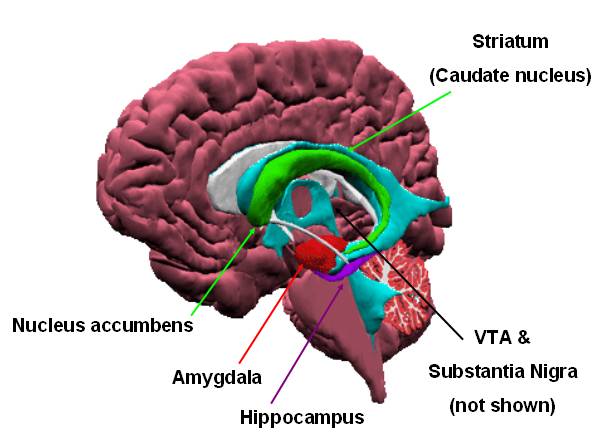The Field of Learning
My main interest is in the ability of a system to adapt to its
surroundings and improve its performance through exposure to a
problem. Systems of this type are commonplace in nature, including
animal brains, immune systems, evolution of genetic material, the laws
and languages of a society, and even the way in which a plant grows
towards a light. These and related ideas, have been modelled
extensively by researchers in a variety of areas including machine
learning, genetic algorithms, reinforcement learning, neuroscience,
psychology, ethology, biology, computer science and physics.
The field is large and further distinctions are useful. For
example, is adaptation in-lifetime or outside-lifetime? Is
learning supervised, unsupervised or reinforced? Is the
system natural or artificial? If artificial, is the model
symbolic or sub-symbolic? The level of description is also a key
distinction - neuronal, behavioural, psychological, social etc.
I am specifically interested in in-lifetime,
sub-symbolic approaches to learning with an emphasis on
unsupervised and reinforcement techniques applied to the lower levels
of description such as those at the focus of behavioural and neuronal
modelling. My academic background is in Artificial Intelligence,
Cognitive Science and Computer Science, and I am particularly
interested in multi-disciplinary approaches to increasing our
understanding of intelligence and learning.
Computational models of dopamine
My current interests revolve around building computational models of
mesolimbic dopamine function. Dopamine is a major neuromodulator in
the brain and is implicated in a number of psychiatric disorders
including psychosis (schizophrenia), Attention Deficit/ Hyperactivity
Disorder (ADHD), Parkinson's disease, Tourette's syndrome and drug
addiction. All but drug addiction are conditions for which the first
line treatment involves dopamine manipulation. Tourette's and
Parkinson's are more likely to involve the Nigrostriatal dopaminergic
pathways, but the others are all likely to depend heavily on the
mesolimbic dopaminergic system, with particular emphasis on the
nucleus accumbens. The diagram below indicates the target brain
regions of the mesolimbic dopaminergic system (thought to be
implicated in psychosis for example).

The mesolimbic dopaminergic system has also been studied extensively within a variety of experimental paradigms leading to 50 years of experimental data to model! Our aim is to model as much of the data pertaining to the mesolimbic dopamine system as possible. Our ultimate aim is to gain a better understanding of psychosis, ADHD and drug addiction.
Particular data to model includes:
- Salamone et. al. (1997) demonstrate that under dopamine blockade, rats prefer a small but easily obtained reward over a previously preferred larger reward that is harder to obtain. If the easy reward is removed then the animal returns to the more inaccessible reward.
- In Attention Deficit/Hyperactivity Disorder (ADHD), the patient is prone to impulsivity. For example, the patient prefers immediate payoffs over holding back for a greater payoff at a later time. The treatment for ADHD involves enhancing dopamine levels.
- Incentive Salience. A key finding presented in Berridge (1998) is that if a rat is deprived of almost all its mesolimbic dopamine then it will stop eating, even though it is apparently capable of producing the motoric responses necessary for doing so, and even though the animal is still apparently capable of feeling the pleasure of the food (if artificially fed).
- A basic Instrumental response finding is that an animal trained to press a lever for a reward, presses more under dopamine agonists and less under dopamine antagonists. Moreover, lever pressing is blockaded at doses which still allow the animal to eat if presented with the food directly. This finding is generalised across different reward types and different instrumental responses.
- The Conditioned Avoidance Response (CAR) paradigm has been used extensively to test the potential effectiveness of antipsychotics for the treatment of schizophrenia. A rat that has learned to avoid a shock (US) by fleeing a conditioned stimulus (CS), then fails to respond appropriately to that stimulus under dopamine blockade. Under enough dopamine blockade, the rat will fail to even escape while being shocked, which may be due to motoric incapacitation, extreme motivational incapacitation, or both.
- Incentive Learning. Balleine and Dickinson et. al. (1995) present experimental observations that if a rat is first trained on an instrumental chain leading to a food reward, and then tested in a sated state, only the animal's motivation for the action proximal to the reward is altered. However, in an interesting twist, the motivation for the distal action is also modulated if the animal is re-exposed to the food in the new motivational state.
- Pavlovian Instrumental Transfer (PIT) refers to the ability of a CS that has previously been paired with a reward, to increase motivation for an instrumental response for that same reward. Interestingly, the CS may still increase motivation for an action that is directed at obtaining a reward different to that predicted by the CS. PIT appears to be affected by dopamine manipulation.
For interactive demos of some of our models, follow the links to the neural simulations of dopamine from the home page.